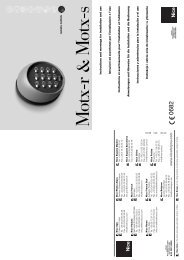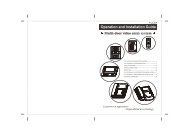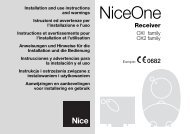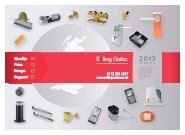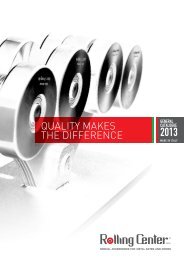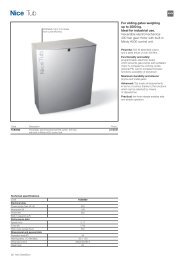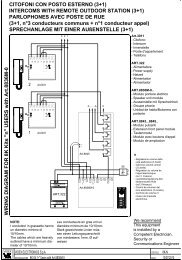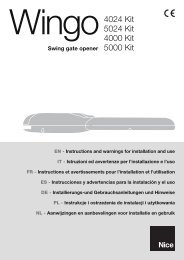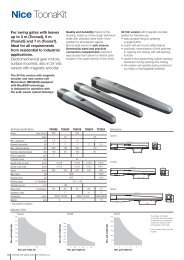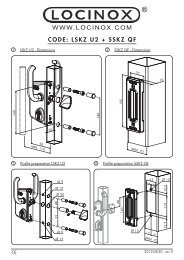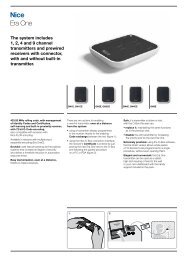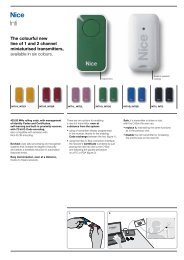Nice Robus Kit 1 - Rolling Center
Nice Robus Kit 1 - Rolling Center
Nice Robus Kit 1 - Rolling Center
You also want an ePaper? Increase the reach of your titles
YUMPU automatically turns print PDFs into web optimized ePapers that Google loves.
2) Product description and applications<br />
ROBUS is a line of irreversible electromechanical gearmotors for the<br />
automation of sliding gates. It is equipped with an electronic control<br />
unit and connector for the optional SMXI or SMXIS radiocontrol<br />
receiver. The electrical connections to external devices have been<br />
simplified through the use of “BlueBUS”, a technique by which several<br />
devices can be connected up using just 2 wires. ROBUS operates<br />
with electric power. In the event of a power failure, the gearmotor<br />
can be released using a special key in order to move the gate<br />
manually. Alternatively, there is the PS124 buffer battery (optional<br />
accessory) which makes it possible to use the gate also during the<br />
event of a power failure.<br />
Other products are also part of the ROBUS line, the difference of which is described in table 1.<br />
Table 1: comparison of the ROBUS gearmotor main characteristics<br />
Gearmotor type RB600 RB600P RB1000 RB1000P<br />
Limit switch type electromechanical inductive proximity electromechanical inductive proximity<br />
Maximum leaf length 8m 12m<br />
Maximum leaf weight 600Kg 1000Kg<br />
Peak thrust 18Nm 27Nm<br />
corresponding to a force) (600N) (900N)<br />
Motor and transformer Motor 24Vcc Ø 77mm Motor 24Vcc Ø 115mm<br />
EI core-type transformer<br />
Toroidal transformer<br />
Note: 1Kg = 9,81N for example: 600N = 61Kg<br />
92mm<br />
303mm<br />
1<br />
330mm<br />
210mm<br />
2.1) Operating limits<br />
Chapter 8 “Technical Characteristics” provides the only data needed<br />
to determine whether the products of the ROBUS line are suitable for<br />
the intended application.<br />
The structural characteristics of ROBUS make it suitable for use on sliding<br />
leaves in conformity with the limits indicated in tables 2, 3 and 4.<br />
data indicated in tables 2 and 3 to establish the number of<br />
cycles/hour, consecutive cycles and maximum speed allowed.<br />
The effective suitability of ROBUS to automate a particular sliding<br />
gate depends on the friction as well as other correlated factors, such<br />
as ice, that could interfere with the movement of the leaf.<br />
For an effective control it is absolutely vital to measure the force necessary<br />
to move the leaf throughout its entire run and ensure that this<br />
is less than half of the “nominal torque” indicated in chapter 8 “Technical<br />
characteristics” (a 50% margin on the force is recommended,<br />
as unfavourable climatic conditions may cause an increase in the<br />
friction); furthermore, it is necessary to take into consideration the<br />
Table 2: limits in relation to the length of the leaf<br />
RB600, RB600P<br />
RB1000, RB1000P<br />
Leave width (m) max. cycle/hour max. no. of consecutive cycles max. cycle/hour max. no. of consecutive cycles<br />
Up to 4 40 20 50 25<br />
4 ÷ 6 25 13 33 16<br />
6 ÷ 8 20 10 25 12<br />
8 ÷ 10 --- --- 20 10<br />
10 ÷ 12 --- --- 16 8<br />
4



